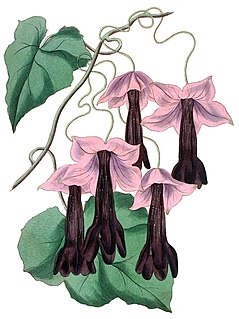
Rhodochiton is a genus of flowering plants within the family Plantaginaceae, native to southern Mexico and neighbouring Guatemala. They climb by means of twining leaf stalks. One of the three species, Rhodochiton atrosanguineus, the purple bell vine, is grown as an ornamental plant. All three species are sometimes included in Lophospermum.
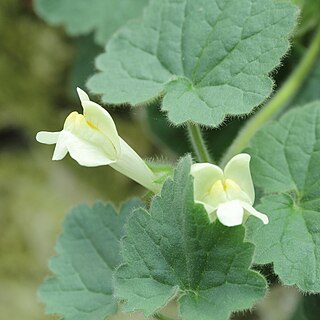
Asarina is a flowering plant genus of only one species, Asarina procumbens, the trailing snapdragon, which is native to southern Europe. Originally placed in the Scrophulariaceae, the genus has more recently been moved to the Plantaginaceae. Species from North America formerly placed in the genus Asarina are now placed in Holmgrenanthe, Lophospermum, Mabrya and Maurandya, as well as Neogaerrhinum. Asarina is now regarded as exclusively an Old World genus.

Maurandya is a genus of flowering plants in the family Plantaginaceae, native to Mexico and the south west United States. They sprawl or climb by means of twining leaf stalks. One of the four species, Maurandya barclayana, is widely cultivated as an ornamental plant.

Holmgrenanthe petrophila is a rare perennial desert plant in the plantain family (Plantaginaceae), and the sole species of the genus Holmgrenanthe. It forms low mats of branched stems growing from a woody base. The leaves have small spines along their edges. The solitary yellow flowers are tubular with five free lobes at the end, the upper two pointing backwards, the lower three projecting forwards. The species is known only from about ten locations, most in the Titus Canyon and the adjacent Fall Canyon, all within the Californian section of Death Valley National Park. It grows in limestone crevices on the canyon walls, often on the north face.

Lophospermum erubescens, known as Mexican twist or creeping gloxinia, is a climbing or sprawling herbaceous perennial plant, native to the Sierra Madre Oriental mountains of Mexico, where it is found along forest margins or canyon walls. It climbs by means of twining leaf stalks. Wild plants have pink and white tubular flowers, although other colours are found in cultivation. It has been cultivated as an ornamental plant since at least 1830. Although not frost-hardy, it will survive if its base and roots are protected from freezing in the winter. It has escaped from cultivation and become naturalized in tropical and subtropical areas of the world, including Hawaii and eastern Australia.
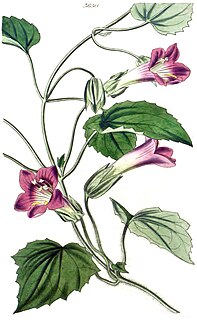
Lophospermum scandens is a scambling or climbing herbaceous perennial native to south central Mexico, with red-violet and white tubular flowers and toothed heart-shaped leaves. It grows at elevations between 1,400 and 2,400 m in dry habitats, including deciduous oak forests and recent lava flows. The long-tubed flowers are pollinated by hummingbirds. It has been used in gardens as an ornamental plant since the mid-19th century. Its roots require protection from frost in regions where this occurs in the winter. Hybrids of L. scandens are also grown.

Mabrya is a genus of flowering plants in the plantain family, Plantaginaceae. It consists of herbaceous perennials with brittle upright or drooping stems, found in dry areas of Mexico and the southern United States.

The Antirrhineae are one of the 12 tribes of the family Plantaginaceae. It contains the toadflax relatives, such as snapdragons. They are probably most closely related to the turtlehead tribe (Cheloneae) and/or a large and badly resolved core group of their family including plants as diverse as water-starworts (Callitriche), foxgloves (Digitalis), and speedwell (Veronica). The Antirrhineae include about 30 genera with roughly 320 species, of which 150 are in genus Linaria. The type genus is AntirrhinumL.
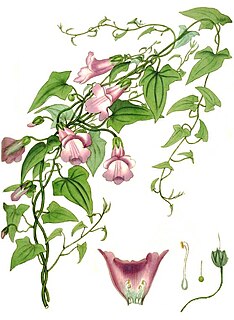
Maurandya scandens is a climbing herbaceous perennial native to Mexico, with pink and white tubular flowers and untoothed leaves. It is grown as an ornamental plant in many parts of the world, and has commonly escaped from cultivation to become naturalized. It has been confused with Lophospermum scandens, which has longer flowers and larger, toothed leaves. It resembles Maurandya barclayana, which has blue-violet flowers and hairy rather than hairless sepals.
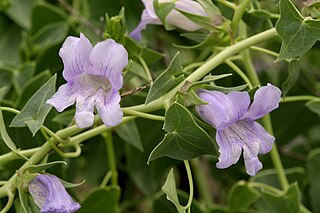
Maurandya wislizeni is a scrambling or climbing herbaceous annual native to Mexico and the south western United States where it grows in sand dunes. It has tubular flowers in shades of blue to violet and white and more-or-less triangular untoothed leaves. It has been placed in a separate genus as Epixiphium wislizeni.
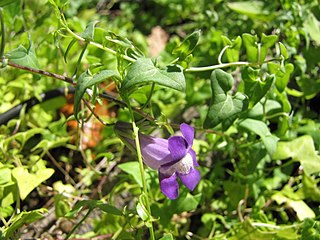
Maurandya antirrhiniflora, known as roving sailor or climbing snapdragon, is a scrambling or climbing herbaceous perennial native to Mexico and the south western United States where it grows in a variety of relatively dry habitats. It has more-or-less triangular untoothed leaves and tubular flowers in various shades of pink, red or blue to violet with white bases. Unlike other species in the genus Maurandya, the flowers have closed "lips"; it has sometimes been put into a separate genus as Maurandella antirrhiniflora.

Lophospermum purpusii is a scambling or climbing herbaceous perennial native to Mexico. It has tubular flowers, white at the base and red to violet elsewhere.
Rhodochiton hintonii is a climbing or sprawling herbaceous perennial native to the state of Guerrero in Mexico. It has dangling flowers, with a bell-shaped calyx and dark purple petals forming a tube. Unlike the better known Rhodochiton atrosanguineus, the petal tube is asymmetrical with two "lips".
Rhodochiton nubicola is a climbing or sprawling herbaceous perennial native to the state of Chiapas in Mexico and to Guatemala, where it grows in cloud forests at between 1,300 and 3,000 m. It has dangling flowers, with a bell-shaped calyx and dark purple petals forming a tube. Unlike the better known Rhodochiton atrosanguineus, the petal tube is asymmetrical with two "lips".
Lophospermum breedlovei is a climbing or scrambling herbaceous perennial native only to the state of Chiapas in Mexico. It has tubular flowers, white at the base and dark purple elsewhere. It was first described by Wayne J. Elisens in 1985. The epithet breedlovei commemorates Dennis E. Breedlove, described as a "prolific plant collector and authority on the flora of Chiapas".
Lophospermum chiapense is a climbing or scrambling herbaceous perennial known only from one location in the state of Chiapas in Mexico, where it was first collected. It has tubular flowers, white at the base and violet elsewhere. It was first described by Wayne J. Elisens in 1985. The epithet chiapense refers to its place of collection.
Lophospermum turneri is a climbing or scrambling herbaceous perennial native to Guatemala and the state of Chiapas in Mexico, where it was first collected. It has tubular flowers, lavender to violet in colour. It was first described by Wayne J. Elisens in 1985. The epithet turneri commemorates Billie L. Turner, described as "mentor of many students of the Latin American flora".
Mabrya geniculata is a mat-forming herbaceous perennial native to the Mexican states of Sonora and Chihuahua. It has pale yellow tubular flowers. It was first described in 1894 by Benjamin L. Robinson and Merritt L. Fernald in the genus Maurandya and transferred to Mabrya by Wayne J. Elisens in 1985.
Mabrya flaviflora is a mat-forming herbaceous perennial native to a small area in Baja California Norte, Mexico. It has pale yellow tubular flowers. It was first described by Ivan M. Johnston in 1924 in the genus Maurandya and transferred to Mabrya by Wayne J. Elisens in 1985 as Mabrya geniculata subsp. flaviflora. It was restored to a full species within Mabrya by David A. Sutton in 1988. The epithet flaviflora means yellow-flowered.
Mabrya rosei is a mat-forming herbaceous perennial native to the Mexican states of Jalisco and Zacatecas. It has tubular flowers, whitish at the base and red to red-violet at the apex. It was first described by Philip A. Munz in 1926 in the genus Maurandya and transferred to Mabrya by Wayne J. Elisens in 1985. Munz did not explain the origin of the epithet rosei but listed the collector of the type specimen as Joseph Nelson Rose.
















